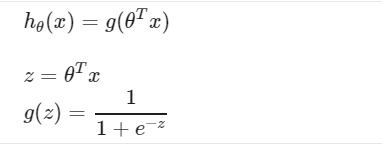Classification and Representation
Classification
-
y ∈ y\in y∈{0,1}
0:“Negative Class”
1:“Positive Class”
The training set is classified arbitrarily as 0 or 1.
classification is not actually a linear function
binary classification problem
-
y can take on only two values, 0 and 1
Logistic Regression
0 ≤ h θ ( x ) ≤ 1 0\leq h_\theta(x)\leq1 0≤hθ?(x)≤1
-
Hypothesis Representation
- Doesn’t make sense for h θ ( x ) h_\theta (x) hθ?(x) to take values larger than 1 or smaller than 0 when we know that y ∈ {0, 1}.
? \Rightarrow ? change the form for our hypotheses h θ ( x ) h_\theta (x) hθ?(x) to satisfy 0 ≤ h θ ( x ) ≤ 1 0 \leq h_\theta (x) \leq 1 0≤hθ?(x)≤1.( by plugging θ T x \theta^Tx θTx into the Logistic Function)
Sigmoid Function(Logistic Function)

The sigmoid function looks like:

The function g(z) shown here maps any real number to the (0, 1) interval, making it useful for transforming an arbitrary-valued function into a function better suited for classification.
h θ ( x ) h_\theta(x) hθ?(x) will give us the probability that our output is 1.
Decision Boundary
decision boundary :
The line that separates the area where y = 0 and where y = 1. It is created by our hypothesis function.
To get our discrete 0 or 1 classification:

And

Remember:

The decision boundary is a property not of the training set, but of the hypothesis and of the parameters.
So as long as we’ve given the parameter vector θ \theta θ, that is what defines the decision boundary.
the parameter vector θ \theta θ, that is what defines the decision boundary.
The training set may be used to fit the parameters θ \theta θ.